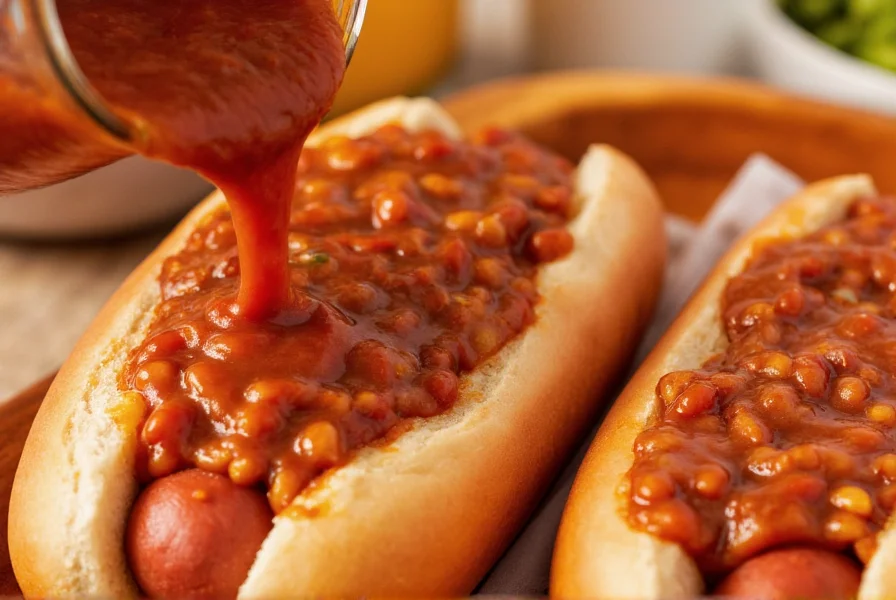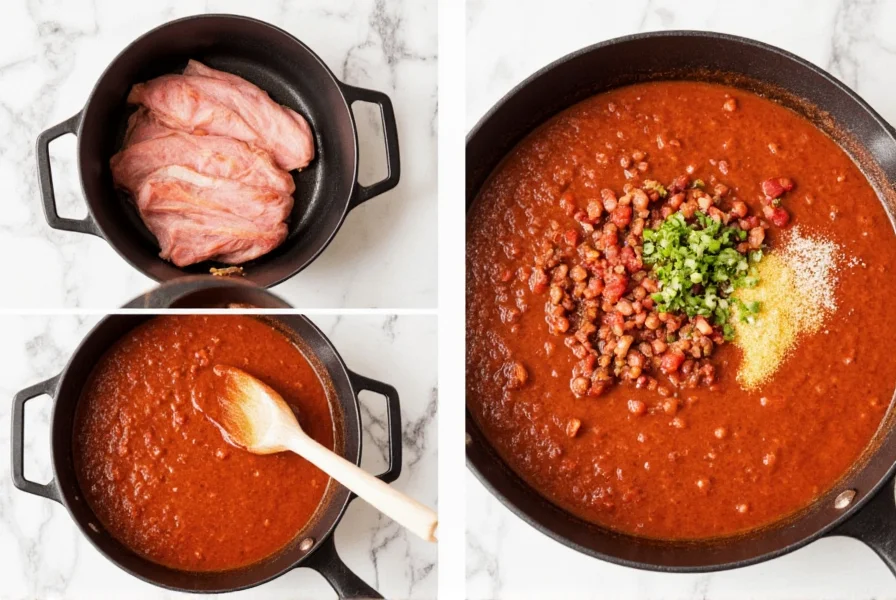Creating the perfect chili dog sauce requires understanding its unique characteristics that differentiate it from standard chili recipes. While regular chili often features chunky meat, beans, and robust spices designed to stand alone as a meal, chili dog sauce serves as a complementary topping that enhances the hot dog without overwhelming it. This distinction is crucial for achieving authentic results whether you're making Cincinnati-style, Detroit Coney Island, or California street vendor variations.
Essential Components of Authentic Chili Dog Sauce
The foundation of any quality chili dog sauce starts with the right ingredients and proportions. Unlike regular chili recipes that might include beans or large meat chunks, traditional chili dog sauce relies on specific elements that create its signature texture and flavor profile.
Ground beef forms the protein base, preferably with 15-20% fat content to ensure richness without excessive grease. The meat should be finely ground (often passed through a meat grinder twice) to achieve the smooth, almost paste-like consistency that characterizes authentic chili dog sauce. Onion provides essential sweetness and aroma, while a carefully balanced spice blend creates the distinctive flavor without overpowering heat.
Liquid components are critical for achieving the proper chili dog sauce texture. Most traditional recipes use a combination of water or broth with tomato products (either tomato paste or sauce), creating a thinner consistency than regular chili while maintaining rich color and flavor. The absence of beans is non-negotiable in authentic preparations, as they would disrupt the smooth texture necessary for proper hot dog coating.

Regional Variations Across America
Chili dog sauce isn't a one-size-fits-all condiment. Different regions have developed distinctive styles that reflect local tastes and culinary traditions. Understanding these variations helps you choose or create the perfect sauce for your preferences.
| Regional Style | Key Characteristics | Signature Ingredients | Texture Profile |
|---|---|---|---|
| Cincinnati | Sweet, cinnamon-forward, Mediterranean-inspired | Ground beef, cocoa, cinnamon, Worcestershire | Thin, smooth, almost gravy-like |
| Detroit Coney Island | Meatier, spicier, more traditional chili flavor | Finely ground beef, onion, garlic, chili powder | Thick but pourable, no chunks |
| Texas Style | Beef-forward, minimal spices, tomato-free | Beef drippings, coarsely ground beef, cumin | Chunkier than other styles, hearty |
| California Street Vendor | Sweet and spicy balance, tomato-based | Tomato sauce, brown sugar, chili powder, mustard | Smooth, medium thickness |
Step-by-Step Recipe for Classic Homemade Chili Dog Sauce
Creating authentic chili dog sauce from scratch requires attention to detail but yields far superior results compared to canned alternatives. This easy chili dog sauce recipe produces enough for 12 hot dogs and can be customized to match your preferred regional style.
Ingredients
- 1 lb (450g) 80/20 ground beef
- 1 large yellow onion, finely minced
- 2 cloves garlic, minced
- 2 tbsp chili powder
- 1 tsp cumin
- 1 tsp paprika
- 1/2 tsp oregano
- 1/4 tsp cayenne pepper (optional)
- 1 tbsp tomato paste
- 1 cup beef broth
- 1 tbsp Worcestershire sauce
- 1 tsp brown sugar
- Salt and black pepper to taste
Preparation Instructions
- Brown the ground beef in a large skillet over medium heat, breaking it into very fine pieces as it cooks. Drain excess fat but retain about 1 tablespoon for flavor.
- Add the minced onion and garlic, cooking until translucent (about 5 minutes).
- Stir in all dry spices (chili powder, cumin, paprika, oregano, cayenne) and cook for 1 minute to toast the spices.
- Add tomato paste and cook for another minute, stirring constantly.
- Pour in beef broth, Worcestershire sauce, and brown sugar. Bring to a simmer.
- Reduce heat to low and let simmer uncovered for 25-30 minutes, stirring occasionally, until sauce reaches desired consistency.
- For ultra-smooth texture (recommended for authentic results), pass the sauce through a fine-mesh sieve or blend briefly with an immersion blender.
- Season with salt and pepper to taste. Keep warm until serving.

Common Mistakes to Avoid When Making Chili Dog Sauce
Even experienced home cooks can make errors that compromise the quality of their chili dog sauce. Recognizing these pitfalls ensures you achieve authentic results every time.
Using the wrong meat texture - One of the most common mistakes is using chunky ground beef. Authentic chili dog sauce requires finely ground meat, often processed twice through a meat grinder. If you don't have access to specialty ground meat, cook regular ground beef thoroughly then pass it through a food processor to achieve the proper consistency.
Incorrect liquid ratio - Many homemade chili dog sauce recipes fail because they're either too thick (making hot dogs soggy) or too thin (running off the dog). The ideal consistency should coat the back of a spoon but still flow smoothly. Adjust by adding small amounts of broth to thin or simmering longer to thicken.
Overcomplicating the spice profile - Unlike regular chili recipes that might feature numerous spices, authentic chili dog sauce benefits from restraint. Focus on balancing chili powder, cumin, and paprika without overwhelming the delicate hot dog flavor. Remember, this is a topping, not a standalone dish.
Serving Suggestions for Perfect Chili Dogs
The quality of your chili dog sauce deserves equally thoughtful presentation. Traditional serving methods vary by region but share common principles that maximize flavor and texture.
For the most authentic experience, use all-beef hot dogs with natural casings that provide that distinctive 'snap.' Steam or lightly grill the dogs rather than boiling, which leaches flavor. Place the hot dog in a steamed bun, then generously cover with warm chili dog sauce.
Traditional toppings follow the 'three-way' system popularized by Cincinnati chili parlors:
- Two-way: Hot dog with chili sauce
- Three-way: Hot dog with chili sauce and shredded cheddar cheese
- Four-way: Hot dog with chili sauce, cheese, and either onions or mustard
- Five-way: Hot dog with chili sauce, cheese, onions, and mustard
The cheese should be added while the chili is still hot, allowing it to melt slightly but retain some texture. Raw onions provide a refreshing contrast to the warm, savory sauce, while a touch of yellow mustard cuts through the richness.
Storage and Reheating Guidelines
Proper storage ensures your homemade chili dog sauce maintains quality for future use. When cooled completely, transfer the sauce to an airtight container and refrigerate for up to 5 days or freeze for up to 3 months.
When reheating, add a small amount of water or broth to restore the proper chili dog sauce texture, as the sauce naturally thickens when chilled. Gently warm over low heat, stirring frequently to prevent scorching. Avoid boiling, which can cause the sauce to separate or become grainy.
For best results, reheat only the amount you plan to use immediately. Repeated heating and cooling cycles degrade both texture and flavor. If freezing, portion the sauce into ice cube trays, then transfer the frozen cubes to freezer bags for easy portion control.
Frequently Asked Questions
What's the difference between chili dog sauce and regular chili?
Chili dog sauce differs from regular chili in several key ways: it has a smoother, thinner consistency without bean chunks; features finely ground meat rather than larger pieces; contains a more balanced spice profile that complements rather than dominates the hot dog; and maintains a pourable texture that evenly coats hot dogs without making them soggy. Authentic chili dog sauce never contains beans, which distinguishes it from many regular chili recipes.
How can I thicken my chili dog sauce if it's too thin?
To properly thicken chili dog sauce without compromising texture, simmer it uncovered for 5-10 minutes to allow excess liquid to evaporate. For quicker results, create a slurry by mixing 1 tablespoon cornstarch with 2 tablespoons cold water, then stir it into the simmering sauce. Avoid using flour directly as it can create lumps. Remember that authentic chili dog sauce should remain pourable - it shouldn't have the thick consistency of regular chili.
Can I make chili dog sauce vegetarian?
Yes, you can create a vegetarian version by substituting textured vegetable protein (TVP) or finely chopped mushrooms for the ground beef. Use vegetable broth instead of beef broth and add 1 tablespoon soy sauce or liquid smoke for umami depth. The key is maintaining the fine texture - process the substitute ingredients until they achieve the smooth consistency characteristic of authentic chili dog sauce. Note that vegetarian versions won't have the same traditional flavor profile but can still make delicious hot dog toppings.
Why does my chili dog sauce separate when reheating?
Chili dog sauce separation typically occurs when it's reheated too quickly or at too high a temperature. The fat and liquid components naturally separate when subjected to rapid temperature changes. To prevent this, always reheat sauce gently over low heat while stirring frequently. If separation does occur, whisk vigorously while adding a small amount of cold water - the sudden temperature change helps re-emulsify the sauce. For best results, store sauce with a thin layer of broth on top to create a protective barrier against separation.
How long should I simmer chili dog sauce for optimal flavor?
For optimal flavor development, simmer chili dog sauce for 25-35 minutes after all ingredients have been combined. This allows the spices to meld and the flavors to deepen without overcooking the meat. The sauce should reduce slightly but maintain a pourable consistency. Avoid simmering for more than 45 minutes, as extended cooking can cause the meat to become tough and the sauce to lose its bright flavor profile. The ideal texture should coat the back of a spoon but still flow smoothly when tilted.










 浙公网安备
33010002000092号
浙公网安备
33010002000092号 浙B2-20120091-4
浙B2-20120091-4